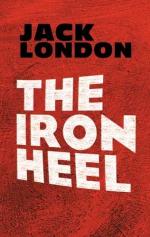* Du Bois, the present
librarian of Ardis, is a lineal
descendant of this revolutionary
pair.
The two girls arrived in a flurry of excitement, danger, and sudden death. In the crew of the fishing boat that conveyed them across San Pablo Bay was a spy. A creature of the Iron Heel, he had successfully masqueraded as a revolutionist and penetrated deep into the secrets of our organization. Without doubt he was on my trail, for we had long since learned that my disappearance had been cause of deep concern to the secret service of the Oligarchy. Luckily, as the outcome proved, he had not divulged his discoveries to any one. He had evidently delayed reporting, preferring to wait until he had brought things to a successful conclusion by discovering my hiding-place and capturing me. His information died with him. Under some pretext, after the girls had landed at Petaluma Creek and taken to the horses, he managed to get away from the boat.
Part way up Sonoma Mountain, John Carlson let the girls go on, leading his horse, while he went back on foot. His suspicions had been aroused. He captured the spy, and as to what then happened, Carlson gave us a fair idea.
“I fixed him,” was Carlson’s unimaginative way of describing the affair. “I fixed him,” he repeated, while a sombre light burnt in his eyes, and his huge, toil-distorted hands opened and closed eloquently. “He made no noise. I hid him, and tonight I will go back and bury him deep.”
During that period I used to marvel at my own metamorphosis. At times it seemed impossible, either that I had ever lived a placid, peaceful life in a college town, or else that I had become a revolutionist inured to scenes of violence and death. One or the other could not be. One was real, the other was a dream, but which was which? Was this present life of a revolutionist, hiding in a hole, a nightmare? or was I a revolutionist who had somewhere, somehow, dreamed that in some former existence I have lived in Berkeley and never known of life more violent than teas and dances, debating societies, and lectures rooms? But then I suppose this was a common experience of all of us who had rallied under the red banner of the brotherhood of man.
I often remembered figures from that other life, and, curiously enough, they appeared and disappeared, now and again, in my new life. There was Bishop Morehouse. In vain we searched for him after our organization had developed. He had been transferred from asylum to asylum. We traced him from the state hospital for the insane at Napa to the one in Stockton, and from there to the one in the Santa Clara Valley called Agnews, and there the trail ceased. There was no record of his death. In some way he must have escaped. Little did I dream of the awful manner in which I was to see him once again—the fleeting glimpse of him in the whirlwind carnage of the Chicago Commune.




